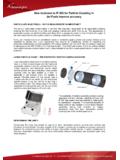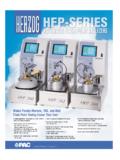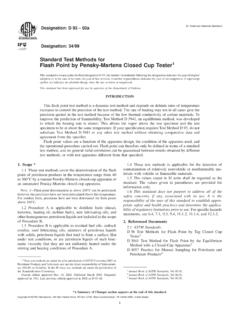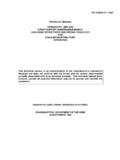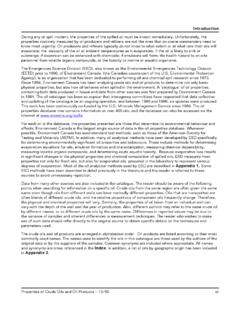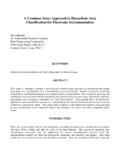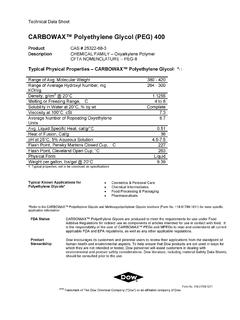Transcription of Flash Point Testing Explained: What is Flash Point?
1 What is Flash Point ? Flash Point is defined as the lowest temperature of a liquid at which its vapours will form a combustible mixture with air. It is a convenient and reliable classification of the flammability of many substances, there are three main categories;Extremely flammable: Flash Point below 0oCHighly flammable: Flash Point below 21oCFlammable: Flash Point below 55oCA sample of specified volume is introduced to the test cup which is maintained at the test temperature. After a specified time, a test flame is applied and the presence or absence of a Flash measure Flash Point ?Quality Control Petroleum and Chemical Industries often use Flash Point Testing to check for contamination or adulteration of product. Multiple storage tanks may contain different product which can range in purity. These tanks may use common pipeline systems. The pipeline will be cleaned between product batch but there is a risk of contamination if they are not cleaned thoroughly.
2 Flash Point is used to determine whether contamination of a product has occurred. Changes in Flashpoint indicate that a sample may have been contaminated or adulterated, for example petroleum spirit in engine oil will lower the flashpoint. Contamination of fuel oil, lubrication oil and hydraulic oil by lighter hydrocarbons can lead to problems with the operation of expensive equipment for example on ships, at power plants and in construction and mining machinery. Flash Point Testing Explained: What is Flash Point ?t: +44 (0) 1932 564391 | e: | Point can indicate the possible presence of highly volatile and flammable materials in a relatively non-volatile or non-flammable material. For example, an abnormally low Flash Point on a sample of kerosene can indicate gasoline will quickly determine changes in flashpoint (within 1 or 2 mins) which may indicate that a sample has been contaminated (during storage) or has been subject to deliberate adulteration.
3 Transport & Storage Regulations Hazard ClassificationMany industries use solvents in their products (paints, vanishes) which is used to classify the flashpoint for the finished product. Some solvents are not highly flammable so establishing the exact flashpoint can save money. Users would be advised to use the Setaflash test method in these circumstances as it quickly provides an accurate Flash Point value to correctly classify the true hazard nature of a product. Waste Disposal RegulationsFlash Point is used in shipping and safety regulations to define flammable and combustible materials and classify their hazard potential which has significant cost implications when transporting or storing products. EU guidelines and Hazardous Waste Regulations now require rapid hazard classification of a sample (liquids, used oils and solids) before it can be disposed of. Portable Setaflash Series 3 Flash Point testers are widely used in these circumstances for spot checks in the laboratory, on a production line or outdoors.
4 They reduce problems with waste handling and disposal owing to the fact a test requires no more than 4ml of Point Testing Explained: Types of Flash Point TestStanhope-Seta, London Street, Chertsey, Surrey, KT16 8AP, UK t: +44 (0) 1932 564391 | e: | CUP (CC)Abel, Abel-Pensky, Pensky-Martens, Tag (CC) & Setaflash (CC)Closed cup tests aim to simulate the situation of a liquid spill in a closed environment. If the liquid is at, or above, its Flash Point then a fire or explosion is a possibility when exposed to a potential closed cup tests the sample is placed inside a sealed (closed) test cup and the ignition source is introduced to measure the temperature at which the sample ignites ( flashes ), known as its Flash Point . OPEN CUP (OC)Cleveland & Setaflash (OC)Open cup tests simulate the potential ignition of liquid spillage in uncontained conditions, for example a pool of liquid split on the floor.
5 Fire Point , combustibility and sustained burning tests all use open cup instruments. Fire Point may be considered as the lowest temperature of the liquid at which vapour combustion and burning commences when an ignition source is applied and continues to burn after the removal of the ignition source. Combustibility and sustained burning tests are usually carried out at a fixed temperature and test for continuous burning of the test open cup instrument will always give a higher Flash Point than a closed cup as the open cup allows free loss of vapours to the atmosphere above the instrument. Closed cup tests are usually specified due to improved open cup tests the sample cup is not enclosed but heated openly and an ignition source is introduced over its surface at intervals to check for an ignition Flash . TEST METHODOLOGY1. NON-EQUILIBRIUM Abel, Pensky-Martens, Tag and ClevelandThe term non-equilibrium means that the vapour is not in equilibrium with the liquid.
6 Non-equilibrium Flash Point tests are when the liquid is heated at a steady rate of temperature increase while the ignition source is applied at regular interval. Advantages: It is well suited to automation, instrumentation is universally available and standardised for a wide range of : Each time the flame is dipped, some of the volatile components may escape which can give artificially high Flash points or spoil precision. The temperature of the liquid and vapour can significantly vary in the cup. Non-equilibrium tests require a large sample size of 50 to 80ml per EQUILIBRIUM SetaflashTraditional equilibrium Flash Point tests which use any cup in a water bath, ensure that the liquid and vapour of the sample are in temperature equilibrium by adopting a complex procedure and a very slow heating rate. The Setaflash Small Scale method overcomes the laborious processes associated with the other methods by utilising a 2ml or 4ml sample which achieves Rapid Equilibrium between the vapour and the liquid in a cup and gives a reliable Flash Point result in just one or two minutes.
7 Advantages: Improved precision compared to non-equilibrium Setaflash instrument range offers low cost, fast measurement for a Flash /no Flash result which is widely used by many industries. Disadvantages: Traditional testers can involve a laborious process especially when larger amounts of sample are needed to produce a representative sample. This type of instrumentation not universally available. Seta s Flash Point Resource CentreStanhope-Seta has over 70 years experience in Flash Point testingfor all test methods including Pensky-Martens, Small Scale, Tag,Cleveland and online Flash Point resource centre aims to provide visitors withinformation about Flash Point Testing and the relevant test methodsas well as offer guidance about choosing the correct instrument foryour sample. Product Locator Flash Point Testing advice Guidance for the right tester for your Video DemonstationSetaflash: : > PM-93 Test Area> Cleveland Test AreaWhich Flash Point Test?
8 The appropriate method for your sample is usually cited in a product specification or regulation, and in certain circumstances a referee test method may be stated, this method should be the first choice. If a number of alternative test methods are specified then the choice will be influenced by other factors such as sample size requirements, speed of Testing or precision and availability of test specifically Testing for contaminants, certain test methods and procedures are more appropriate than others. In general an equilibrium test method is recommended for Testing samples that may contain traces of volatile SMALL SCALEASTM D1655, ASTM D3278, ASTM D3828, ASTM E502, BIS IS 1448 Part 20, BS 3900 Part A13, BS 6664 Parts 3 & 4, BS EN 456, CHIPS Regulations, DEF STAN 91-91, EPA 1020 A & B, IP 523, IP 524, ISO 3679, ISO 3680, UN Class 3 Non-viscous Flammable LiquidsThese methods cover petroleum products and biodiesel liquid fuels across the range of 30 to 300 C using a small scale closed cup tester.
9 The procedures may be used to determine whether a product will or will not Flash at a specified temperature ( Flash /no Flash Method A), or the Flash Point of a sample (Method B). When used in conjunction with an electronic thermal Flash detector, these methods are also suitable for Flash Point tests on biodiesels such as 524 and EN ISO 3680 (Method A) are similar methods for Flash no- Flash tests. IP 523 and EN ISO 3679 (Method B) are similar methods for Flash Point PENSKY-MARTENS CLOSED CUP (PMCC)ASTM D93, IP 34, ISO 2719 These test methods cover the determination of the Flash Point of petroleum products in the temperature range from 40 to 360 C by a manual or automated PMCC apparatus. They are also used to determine the Flash Point of biodiesel in the temperature range of 60 to 190 C by automated PMCC D56, ASTM D3934, ASTM D3941, ASTM E502, IP 491, IP 492, ISO 1516, ISO 1523 This test method covers the determination of the Flash Point , by tag manual and automated closed testers, of liquids with a viscosity below mm2/s (cSt) at 40 C, or below mm2/s (cSt) at 25 C, and a Flash Point below 93 the closed-cup Flash Point of liquids with the following properties: a viscosity of mm2/s (cSt) or more at 40 C; a viscosity of mm2/s (cSt) or more at 25 C; a Flash Point of 93 C or higher; a tendency to form a surface film under test conditions; or containing suspended solids, Test Method D93 can be ASTM D92; DIN 51376.
10 AASHTO T48 This test method describes the determination of the Flash Point and fire Point of petroleum products by a manual Cleveland open cup apparatus or an automated Cleveland open cup apparatus. It is applicable to all petroleum products with Flash points above 79 C and below 400 C except fuel 170, IP 491, IP 492, ISO 1523, ISO 13736 This test method describes the determination of the closed cup Flash Point of combustible liquids having Flash points of between -30 and 70 C, inclusive. However, the precision given for this method is only valid for Flash points in the range -5 and Point Testing Explained: Which Flash Point Test?Stanhope-Seta, London Street, Chertsey, Surrey, KT16 8AP, UK t: +44 (0) 1932 564391 | e: | Point Testing Explained: Summary of Flash Point TestersStanhope-Seta, London Street, Chertsey, Surrey, KT16 8AP, UK t: +44 (0) 1932 564391 | e: | Model:Seta Part No:Temperature Range: Test Modes:Sample Size: Test Duration:Cup material.


